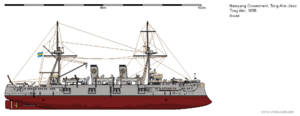Tong Ahn-class cruiser
 Tong Ahn (Dong'an) in 1898
| |
| Class overview | |
|---|---|
| Operators: | Menghe |
| Built: | 1892-1896 |
| In commission: | 1897-1920 |
| Planned: | 2 |
| Completed: | 2 |
| Lost: | 1 |
| Scrapped: | 1 |
| General characteristics | |
| Type: | Armored cruiser |
| Displacement: | 5,903 tons (full) |
| Length: | 105.4 m overall |
| Beam: | 15.5 m |
| Draught: | 7.10 m (full) |
| Propulsion: | Two shafts, two vertical triple-expansion steam engines |
| Speed: | 18.3 knots |
| Range: | 4,400 nautical miles at 10 knots |
| Complement: | 402 officers and men |
| Armament: |
|
| Armour: |
|
The Tong Ahn class was a pair of armored cruisers procured by Menghe's Namyang Government in the 1890s. They were built in Gothia and fitted out in Anglia and Lechernt, carrying mainly Anglian guns. Tong Ahn and her sister ship Tong Mong were built in response to the State of Sinyi's naval modernization program, and featured a flexible main armament of eight 6-inch and ten 4.7-inch guns. They saw extensive service in the closing campaigns of Menghe's Three States Period, with Tong Mong sunk by a torpedo. In 1902, Tong Ahn bombarded coastal targets in the Uzeri Sultanate, and in the 1910s she was converted to a troop transport to support Allied operations in Qusayn. She was sold for scrap in 1920.
Design and description
The two ships of the Tong Ahn class were built for coastal combat against Sinyi naval forces in the area off the coast of what is now Unsan Province, a rugged region dotted with islands and coves. Accordingly, they were small vessels, with limited range and seakeeping. Powered by eight coal-fired boilers driving two triple-expansion steam engines, they were reportedly able to exceed 18 knots in service, modest compared to contemporary cruisers in many of the most modern navies but adequate for their role. Because of their short range on coal, both ships were built with functioning sail rigs, to provide auxiliary power on long ocean voyages. These sails--two square sails and a spanker--were used on their delivery voyages across the Meridian Ocean. At some point before the start of the 1898 naval campaign, both ships had their sails removed and put into storage, and there is no record that they were ever reinstalled.
The Tong Ahn and Tong Mong were armed with a mix of 6-inch and 4.7-inch quick-firing guns, with no high-caliber guns. They were influenced by the theory, popular among some naval thinkers of the time, that a ship with many medium-caliber weapons would be able to overwhelm a ship with a few high-caliber guns. Various 10-inch and 12-inch guns of the 1890s could take up to five minutes to reload, and sometimes much longer, while the 4.7-inch QF Mark I could attain a rate of fire of 6-7 rounds per minute. Even against an opponent with heavy belt and deck armor, the 6- and 4.7-inch barrage would cause extensive damage to the upperworks, setting fires and damaging small gun mounts and rangefinders. This, in turn, would blind the enemy vessel and deplete or suppress her crew, opening the way for follow-up attacks by torpedo boats or the cruiser's own submerged torpedo tubes. In the 1880s, the State of Sinyi had few large warships and still relied mainly on torpedo boats, sailing vessels, and ironclad monitors, adding to the rationale for a cruiser with more medium-caliber weapons.
Anticipating a similar threat of light- and medium-caliber gunfire, Namyang naval staff requested that all 6-inch guns be placed in an enclosed casemate with 6-inch side armor. All 4.7-inch guns were installed in deck mounts with 3-inch-thick gun shields. The tertiary guns, ten 57mm quick-firing Hotchkiss cannons, were all unarmored.
An interesting feature of the Tong Ahn class, shared with some other Namyang vessels of the period, were the two cylindrical "turrets" housing 37mm Hotckhiss rotary cannons. These were not in fact proper turrets, but instead, rotating gunhouses with a pintle mount firing through a large slot-like opening. Powered by steam pressure, but with hand cranks for backup, the gunhouse could traverse to point in the general direction of a target, from which the gunner would aim the cannon manually over a roughly 60-degree arc. The rotating gunhouses were of a "through-deck" type, with the turret crew standing in a hole cut through the deck, and the gunhouse sitting on a ring bolted to the deck around them. The turret crew, consisting of a gunner, a loader, and a director, stand on a non-rotating platform attached to the deck and bulkheads below them, meaning they must shuffle around as the gunhouse turns. These turrets were effective at engaging small ramming or boarding craft, but lacked the range and hitting power to deal with the types of torpedo boats that were becoming common in the 1890s, and they were effectively obsolete by the 1910s.
Ships in the class
| Name | Mengja | Laid down | Launched | Commissioned | Fate |
|---|---|---|---|---|---|
| Tong Ahn (Dong'an) | 同安 | 1892-09-08 | 1896-12-06 | 1898-09-23 | Sold for scrap, 1920 |
| Tong Mong (Dongmong) | 同梦 | 1892-09-19 | 1897-01-31 | 1898-10-14 | Sunk in action, 1898 |